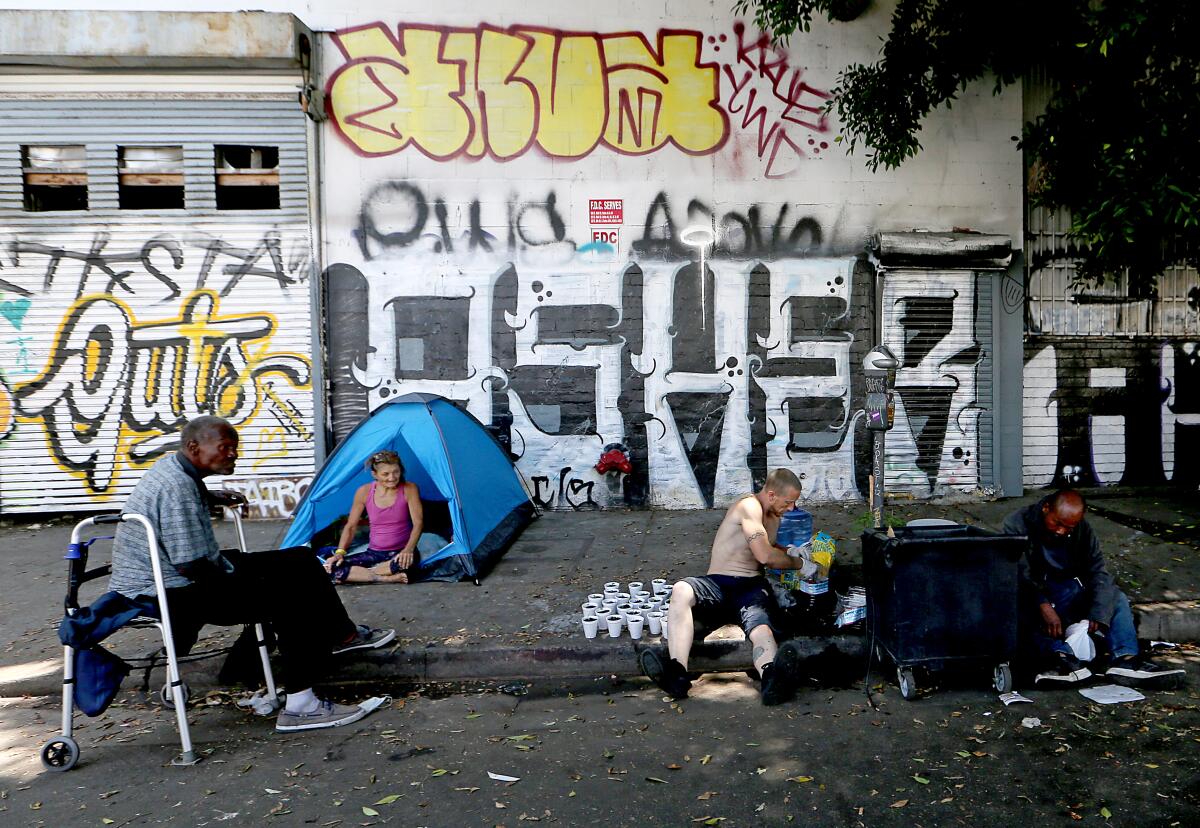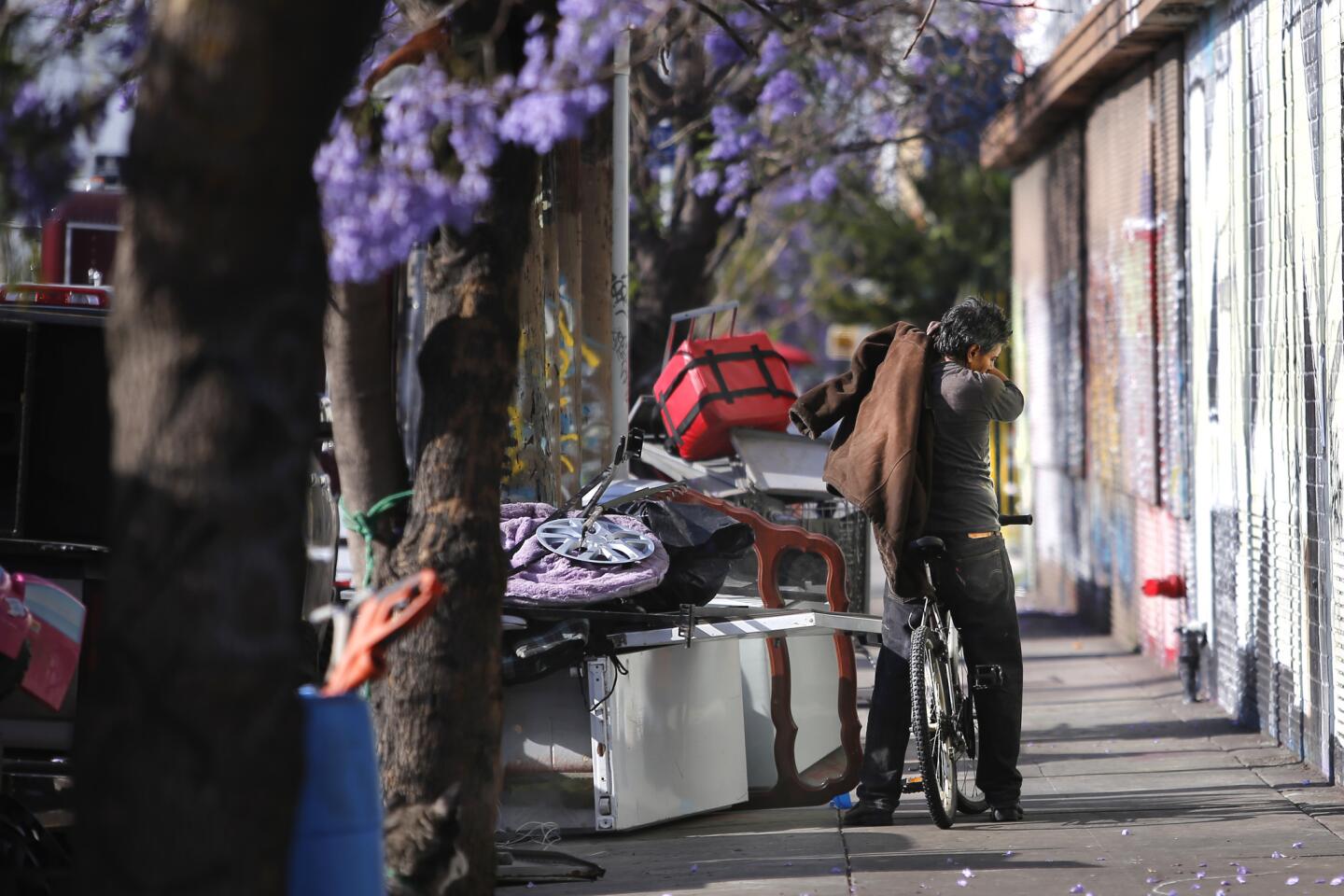L.A. County homelessness jumps a ‘staggering’ 23% as need far outpaces housing, new count shows

- Share via
Los Angeles County’s homeless population has soared 23% over last year despite increasing success in placing people in housing, according to the latest annual count released Wednesday.
The sharp rise, to nearly 58,000, suggested that the pathway into homelessness continues to outpace intensifying efforts that — through rent subsidies, new construction, outreach and support services — got more than 14,000 people permanently off the streets last year.
“Staggering,” Los Angeles County Supervisor Janice Hahn said in a statement. “It is clear that if we are going to end the homeless crisis, we need to stem the overwhelming tide of people falling into homelessness.”
Said Leslie Evans, a West Adams resident active in efforts to combat homelessness in South Los Angeles: “These are scary numbers.”
The startling jump in homelessness affected every significant demographic group, including youth, families, veterans and the chronically homeless, according to the report. Homeless officials and political leaders pointed to steadily rising housing costs and stagnant incomes as the underlying cause.
Homelessness also increased sharply in the city of Los Angeles, where the count of just over 34,000 was up 20% from 2016.
“There’s no sugarcoating the bad news,” Los Angeles Mayor Eric Garcetti said at a news conference Wednesday where the Los Angeles Homeless Services Authority released its report. “We can’t let rents double every year. I was particularly disappointed to see veteran numbers go up.”
Garcetti called homelessness a problem that has persisted “through administrations, through recessions,” adding, “Our city is in the midst of an extraordinary homelessness crisis that needs an extraordinary response. These men, these women, these children are our neighbors.”
The Homeless Services Authority linked the worsening problem to the economic stress on renters in the Los Angeles area. More than 2 million households in L.A. and Orange counties have housing costs that exceed 30% of income, according to data from Harvard University’s Joint Center for Housing Studies included in the report.
According to the nonprofit California Housing Partnership Corp., median rent, adjusted for inflation, increased more than 30% from 2000 to 2015, while the median income was flat.
Currently, the median asking price for rentals countywide is $1,995 for one-bedroom apartments and $2,416 for all multifamily units, according to the real estate website Zillow.
“I am deeply concerned that over the next few years we will continue to be overwhelmed by people for whom rents are simply unsustainable,” Supervisor Sheila Kuehl said in a statement. She called for changes in land use and rent control regulations to boost affordable housing.
Mirroring last year’s count, only one of every four homeless people in both the city and across the county were classified as “sheltered,” meaning they were counted in an emergency shelter or longer-term transitional program. That left three of every four, or just under 43,000 countywide, living on the street.
The chronic homeless population — defined as those who have been on the streets at least a year or multiple times and suffering mental illness, addiction or physical disability — increased 20% to more than 17,000, despite increasing numbers placed into housing.
There were few exceptions to the bad news.
Even the homeless veteran population jumped in 2017, marking a backsliding of the gains made last year by city, state and federal programs that slashed the number of homeless veterans by a third. With the number of veterans placed into housing slightly down, the count of 4,828 homeless veterans was up 57%.
The only hopeful sign of homeless initiatives making headway was the strong increase in the number of homeless families being sheltered. Though the population of homeless families increased nearly 30%, those without shelter dropped 21%.
The 2017 count, conducted in January, will become the baseline for a multibillion-dollar homeless program funded by two successful ballot measures.
Proposition HHH, approved by Los Angeles voters in November, will provide $1.2 billion in bond proceeds over a decade to build permanent housing. Measure H, approved by county voters in March, will provide an estimated $3.5 billion over 10 years for rent subsidies and services. The county Board of Supervisors is scheduled to vote on budgets for the first three years on June 13.
The combined initiatives aim to create or subsidize 15,000 housing units and pay for services to support those living in them.
Voters “have afforded us opportunity we never had … to step forward and confront the problem of homelessness in Los Angeles,” said Supervisor Mark Ridley-Thomas. “I am not at all discouraged by this data. We knew intuitively there was an uptick. ... Now we have the resources to stand up to it.”
Ridley-Thomas called on the community to “put your war clothes on and get ready to fight.”
The Los Angeles count, the largest in the nation, is an estimate based on a street tally conducted by 7,700 volunteers over three days and nights. For the last dozen years, the U.S. Department of Housing and Urban Development has required cities, counties and other regions to conduct a count in order to receive federal homelessness aid.
The numbers give an imperfect snapshot of the highly fluid homeless population at a point in time. The number of people who lose their homes over the course of a year is more than three times greater on a given night, homeless officials say.
Because the homeless authority has refined its methodology over the years and expanded its volunteer base, year-over-year comparisons can be misleading.
Officials acknowledged, for example, that last year’s 11% increase at least partially resulted from the introduction of a special effort to locate hard-to-find youth.
But the scale of this year’s increase left little doubt that homelessness was on the rise.
Earlier this month, Orange County reported an 8% increase in its homeless population over two years. More than half of the county’s nearly 4,800 homeless people were living without shelter.
A 26% increase toppled years of stagnant or declining numbers in Santa Monica, bringing its homeless population to nearly 1,000, the highest number in a decade. City officials said more than half the homeless people came from other parts of the county.
A brighter picture emerged from Long Beach, which conducts its own count. The city recorded a 21% decline in its homeless population, crediting a nearly 200% increase in permanent housing there. But the actual decrease — 482 people — barely affected the regional totals.
In Los Angeles County, the most drastic increase — 48% — occurred in the San Gabriel Valley district of Supervisor Hilda Solis, where the count rose to just under 13,000.
Ridley-Thomas’ district remained the most affected with nearly 19,000 people counted, a 22% increase.
Surveys conducted with the Los Angeles count provided demographic breakdowns for the portion of the county excluding Long Beach, Pasadena and Glendale, cities that conduct their own counts.
These showed increases of 20% or more for every type of improvised shelter — cars (2,147), vans (1,862), campers and recreational vehicles (4,545), tents (2,343) and makeshift shelters (3,516).
Youths made up the fastest growing homeless age group with those 18 to 24 up 64%, followed by those under 18 at 41%.
Those numbers didn’t surprise Heidi Calmus, who works in the Hollywood branch of Covenant House, an international homeless services agency.
Calmus said the agency sees 100 to 150 new homeless youth in Hollywood every month. All the shelters have waiting lists, and permanent housing is impossible to find, even with a rent voucher.
“The system is overwhelmed,” Calmus said.
While blacks remained the largest racial/ethnic group, making up 40% of all homeless people, the number of Latinos grew by almost two-thirds. Whites declined by a modest 2% and Asians, though remaining only 1% of all homeless people, increased by nearly a third.
Three-fourths of homeless people reported they had been in the county for five years or more, while 12% had been residents for less than a year.
Times staff writer Andrew Khouri contributed to this report.
Twitter: @geholland
Twitter: @LATdoug
ALSO
Home at last: Vets’ circuitous paths through homelessness meet in new permanent home
Huntington Beach opposes county supervisor’s proposal for homeless shelter
In Venice, where money meets misery, hoping for an end to homeless camps
UPDATES:
3:05 p.m.: This article was updated with additional details.
11:25 a.m.: This article was updated with additional context and reaction.
9:45 a.m.: This article was updated with reaction.
This article was originally published at 9:20 a.m.
More to Read
Sign up for Essential California
The most important California stories and recommendations in your inbox every morning.
You may occasionally receive promotional content from the Los Angeles Times.



























